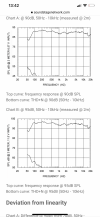In many reviews I have seen that there are graphs of speakers but the associated test amps are not mentioned. Some speakers are high sensitivity and some low and some has weird impedances.
Will distortion figures of speakers change with change in amps?
For example here are two measurements of kef r11 by two different people and distotion is not Same in both.

 www.audiosciencereview.com
www.audiosciencereview.com
Why is it so?
Will distortion figures of speakers change with change in amps?
For example here are two measurements of kef r11 by two different people and distotion is not Same in both.

KEF R11 quick measurements single vs bi-amp
Just wanted to share some measurements I got from my new KEF R11s. mic at 1 meter in room with all reflections active. REW measurements, MacBook to Mytek DAC+ to McIntosh MC462 vs. to Wyred4Sound (W4S) ST1000 (ICE 1000ASP) low (RCA) + MC462 HF (XLR) bi-amp. Using XLR out to the Mc and single...
 www.audiosciencereview.com
www.audiosciencereview.com
Why is it so?

